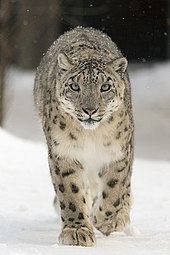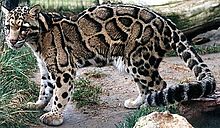Panthera blytheae
| Panthera blytheae | ||||||||||||
|---|---|---|---|---|---|---|---|---|---|---|---|---|
| Temporal occurrence | ||||||||||||
| Late Miocene to Early Pliocene | ||||||||||||
| 5.95 to 4.1 million years | ||||||||||||
| Locations | ||||||||||||
|
||||||||||||
| Systematics | ||||||||||||
|
||||||||||||
| Scientific name | ||||||||||||
| Panthera blytheae | ||||||||||||
| Tseng et al., 2013 | ||||||||||||
Panthera blytheae is an extinct species of the big cats (genus Panthera ). The fossils are the oldest known remains of a species that is assigned to the big cats. They come from the highlands of Tibet in the Himalayas and are dated to the transition from the late Miocene to the early Pliocene between 5.95 and 4.1 million years ago.
The type was about equivalent to today living in size clouded leopard and is closely related to the snow leopard . As the oldest known fossil species of the real big cats, Panthera blytheae supports the genus in Asia, from where it spread to Europe, Africa, North and South America.
features
Fossil material
The description of Panthera blytheae as an independent species was based on several skull fragments. The type material used was a skull fragment consisting of an almost complete facial skull (IVPP V18788.1) with an existing left zygomatic arch and several complete teeth (first left incisor , both canines and the third and fourth premolar ). The tooth cavities (alveoli) also indicate the existence of a small, reduced, second premolar and a very large first molar. The incisors and canines are badly worn, in contrast to the sharp and little worn premolars.
As additional material, the species was assigned various other skull fragments and individual teeth from the same and nearby sites, including a partially traditional right lower jaw with a third and fourth premolar and a first molar. There are no other bones in the skeleton.
Feature reconstruction and comparison with other species

Using the existing, partially dorsoventrally pressed, skull material, a skull reconstruction was worked out with the aid of X-ray computed tomography , which can be used for comparison with other species of the genus Panthera . The skull of Panthera Blytheae is therefore approximately the same size as that of the clouded leopard ( Neofelis nebulosa ) and about 10% smaller than that of the snow leopard ( P. uncia ). The width of the snout in relation to the rest of the skull is between that of the clouded leopard and the panthera species living today .

The skull reconstruction also shows a well-developed frontal sinus in the anterior postorbital area, which corresponds to that of large cats living today. The frontal sinus and some other features such as the size of the lower jaw, however, correspond more closely to those of larger cats living today than the snow leopard. The ratio of the tooth sizes to one another corresponds more to that of a clouded leopard than a panthera species. The size of the premolars in the lower jaw is comparable to that of various small cats , such as the ocelot ( Leopardus pardalis ), with the first molar being significantly larger in proportion.
Panthera blytheae shares numerous specific skull features with the snow leopard, including the almost round cross-section of the canine teeth and a depression around the front area of the nasal bones . Separate features can be found primarily on the teeth, such as a small additional tooth tip on the upper third and a groove on the upper fourth premolar.
Location and chronological order
The fossils for the first description come from the highlands of Tibet in the Himalayas . The site is located in the Zanda Basin in the Zanda District in the eastern part of the Ngari District and thus in the far west of the Tibet Autonomous Region in the People's Republic of China . The site (31 ° 39'58 "N, 79 ° 44'57" E) is at an altitude of 4114 meters and is referred to as IVPP ZD1001, the formation as the Zanda Formation. The fossils IVPP V18788.1–3 come from a small bone deposit in the center of the formation and were found in greenish, coarse sandstone.
The fossil material of the type material is estimated to be 4.42 million years old, the estimate being derived from the assumed age of the site, which is stratigraphically correlated with the layer C3n.1r. All of the available material falls within a period that was 5.95 to 4.1 million years ago. Thus the age of the fossils falls on the transition from the late Miocene to the early Pliocene and the period in which the highlands of Tibet, the northernmost part of the Himalayas, were raised when it was formed.
Way of life and paleoecology
Like all other fossil and recent species of the big cats that are still alive today, Panthera blytheae was also a carnivore that probably fed on smaller mammals.
Taxonomy
The first scientific description of the fossils of Panthera blytheae as a separate species within the real big cats (genus Panthera ) took place in 2013 by a working group led by the paleontologist Z. Jack Tseng from the American Museum of Natural History .
|
Systematics of the big cats according to Tseng et al. 2013
|
Panthera blytheae is thus the oldest known species of the genus Panthera , the oldest fossils of which have been found in Africa and to a contradiction between the fossil history of the genus and the phylogenetic family tree based on molecular biological methods , which suggests an origin of the genus in Asia. This contradiction could be resolved through the discovery and description of Panthera blytheae. The closest relative of the species is assumed to be the snow leopard ( P. uncia ) that lives in the Himalayas today .
The phylogenetic analysis of the first description showed that Panthera blytheae is closely related to the snow leopard and the tiger ( P. tigris ). The close relationship between the tiger and the snow leopard is not confirmed by other studies, including the first description of the fossil Panthera zdanskyi in 2011. There the snow leopard takes on the position as sister species of all known fossil and recent Panthera species. Tseng and colleagues also show that most relationships in the cladogram are only weakly supported, with the exception of the sister species relationship of the snow leopard and Panthera blytheae .
Biogeography and speciation
A historical biogeography for the genus Panthera can be derived from the family tree and the age of the fossils, i.e. a history of global settlement by the various species of the genus. This suggests that the genus originated in Central Asia and that it spread to South Asia, Europe, Africa and North America. The oldest species formations of the big cat branch are in the late Miocene, when almost all fossil and still living species developed from a common ancestor. An exception is the evolutionary branch from which the lion living today as well as the fossil American lions and cave lions emerged.
The strong tectonic activity caused by the rise of the northern Himalayas is cited as an explanation for the high speciation rate in the Miocene, especially in the region of today's Tibetan highlands. It also affected other animal groups such as the pika , fox and antelope and is seen as the starting point for the ecological networks of the Tibetan highlands that still exist today.
Naming
Panthera blytheae was named after the daughter Blythe of Paul and Heather Haaga, who did a great job protecting birds at the Natural History Museum of Los Angeles County .
supporting documents
- ↑ a b c d e f g h i j k l m n Z. Jack Tseng, Xiaoming Wang, Graham J. Slater, Gary T. Takeuchi, Qiang Li, Juan Liu, Guangpu Xie: Himalayan fossils of the oldest known pantherine establish ancient origin of big cats. Proceedings of the Royal Society B - Biological Sciences vol. 281 no. 1774 20132686, November 2013. doi : 10.1098 / rspb.2013.2686
- ↑ a b Ji H. Mazák, Per Christiansen, Andrew C. Kitchener: Oldest Known Pantherine Skull and Evolution of the Tiger . In: PLoS ONE . 6, No. 10, 2011, p. E25483. doi : 10.1371 / journal.pone.0025483 .
literature
- Z. Jack Tseng, Xiaoming Wang, Graham J. Slater, Gary T. Takeuchi, Qiang Li, Juan Liu, Guangpu Xie: Himalayan fossils of the oldest known pantherine establish ancient origin of big cats. Proceedings of the Royal Society B - Biological Sciences vol. 281 no. 1774 20132686, November 2013. doi : 10.1098 / rspb.2013.2686
